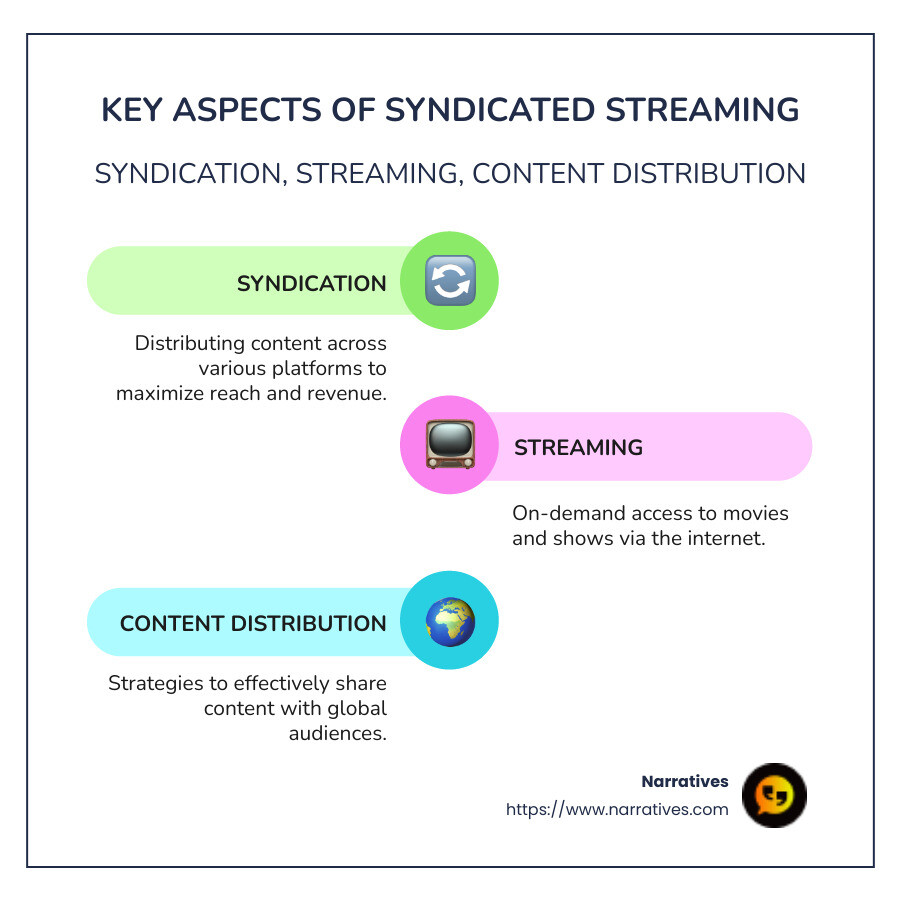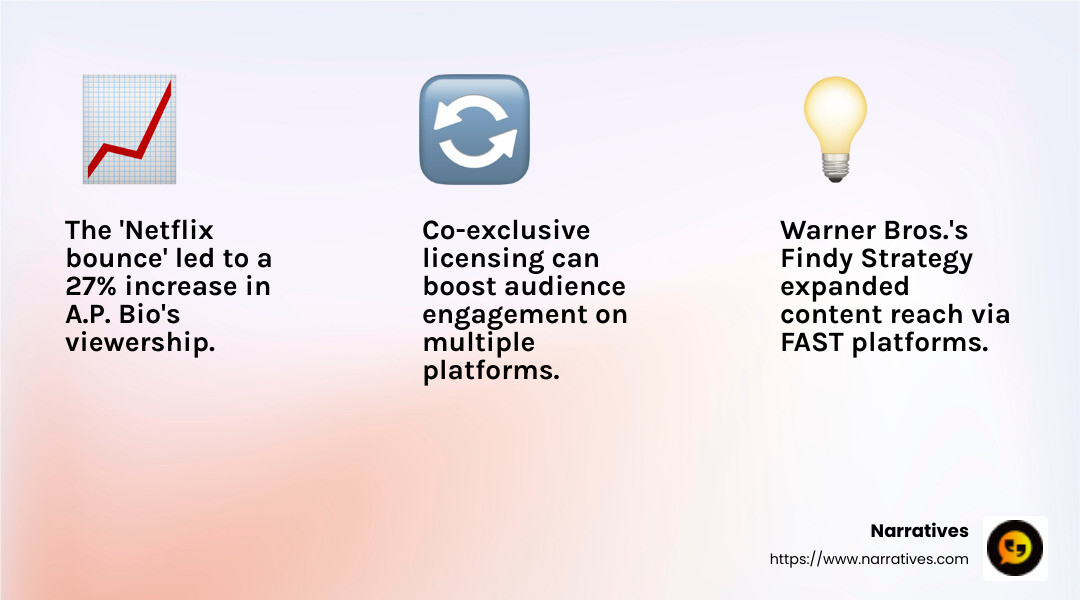Syndicated Streaming: A New Era for Content Consumption

Syndicated streaming service content has transformed how we distribute and consume media today. At its core, syndicated streaming involves licensing and sharing content across multiple platforms, making it possible for creators to reach vast audiences and generate additional revenue by using a single piece of content. This method has proven beneficial for maximizing exposure and profitability in an ever-growing market of streaming platforms.
Syndication: A strategic move to increase a show's or movie's reach by distributing it across various streaming services.
Streaming: Enjoy watching movies, shows, and more on-demand via the internet.
Content Distribution: The methodology and strategy used to share content with audiences globally.
Gone are the days when content solely meant static broadcasts on traditional TV networks. Now, streaming services like Netflix, Amazon Prime Video, Disney+, and many more have opened doors for innovative syndication models. For instance, once fiercely protective of their original content, platforms are now beginning to reconsider their exclusivity rules in favor of increased visibility and potential financial gain.
In this evolving landscape, content is not just king; distribution is the crown that amplifies its reach.

Syndicated streaming service content word roundup:
Understanding Syndicated Streaming Service Content
The Evolution of Syndication
Syndication has come a long way from its traditional roots in broadcast television. Originally, broadcast syndication involved selling TV shows to multiple local stations. This allowed popular programs to reach broader audiences without being tied to a single network. Fast forward to today, and we have streaming syndication, where content is licensed to multiple streaming platforms, extending its reach even further.
In the modern streaming era, syndicated streaming service content enables shows and movies to be shared across various services like Netflix, Amazon Prime Video, and others. This evolution reflects a shift in how content is consumed, moving from fixed broadcast schedules to on-demand streaming. The change from traditional to streaming syndication represents a significant change in media distribution, allowing creators to tap into global audiences with ease.
Benefits of Syndicated Streaming
Syndicated streaming offers numerous advantages for content creators and distributors. Here are some key benefits:
Revenue Potential: By licensing content to multiple platforms, creators can open up additional revenue streams. This approach allows them to earn from different sources, maximizing the financial potential of their work.
Audience Reach: Syndication expands a show's or movie's visibility. By distributing content across multiple platforms, creators can attract a diverse and global audience, increasing their fan base and engagement.
Content Monetization: Syndicated streaming provides various monetization opportunities. For instance, content can be licensed to free ad-supported platforms, generating income through advertising. Alternatively, it can be part of subscription-based services, offering a share of the subscription revenue.

Syndication is not just about reaching more people; it's about smartly utilizing content to generate sustained revenue and maintain relevance in a crowded market. As streaming platforms continue to grow, the potential for syndicated streaming service content to reshape the entertainment industry is immense.
This dynamic landscape encourages creators to think strategically about where and how their content is distributed, ensuring they maximize both visibility and profitability.
Next, we'll explore how content creators can effectively syndicate their content, focusing on licensing agreements and distribution strategies.
How to Syndicate Your Content
Choosing the Right Platforms
Selecting the right streaming platforms is a critical step in syndicating your content. The goal is to reach the widest possible audience while ensuring your content aligns with the platform's demographic. Here's how to approach this:
Understand Audience Demographics: Every streaming platform attracts a distinct audience. For instance, a platform like Disney+ might cater to family-friendly content, while others like Hulu or Netflix have a broader range. Analyze the demographic data of each platform to ensure your content finds its ideal audience.
Platform Selection Strategy: Evaluate platforms based on their reach, reputation, and alignment with your content type. Consider platforms that offer both free ad-supported and subscription-based models to diversify your revenue streams.
Niche vs. Mainstream: Decide if your content is better suited for a niche platform with a dedicated audience or a mainstream service that offers broader exposure. Sometimes, starting with a niche platform can build a loyal following before expanding to larger services.
Negotiating Licensing Deals
Once you've chosen the platforms, the next step is negotiating licensing agreements. These deals dictate how your content is distributed and monetized. Here are key elements to focus on:
Licensing Fees: Determine the upfront fees or advances you will receive for your content. This can be a fixed amount or a percentage of the revenue generated. Ensure that the fees reflect the value of your content and the potential audience reach.
Revenue Sharing: Many platforms offer revenue-sharing models, where you earn a percentage of the subscription or ad revenue generated by your content. Negotiate favorable terms that balance immediate compensation with long-term earnings.
Distribution Rights: Clarify the scope of the distribution rights. Decide whether the rights will be exclusive to one platform or non-exclusive, allowing you to license the content to multiple platforms. Non-exclusive rights can maximize exposure and revenue potential.
Performance Metrics: Include clauses that allow for performance evaluation. This can help you renegotiate terms based on viewership, engagement, and audience retention metrics. It's a way to ensure that your content's success translates into better deals.
Syndicating your content effectively requires a strategic approach to platform selection and licensing negotiations. By focusing on these elements, you can maximize both the reach and profitability of your syndicated streaming service content.
Next, we'll dive into real-world examples of successful syndication to illustrate how these strategies play out in practice.
Case Studies in Syndicated Streaming
Successful Syndication Examples
Let's explore some real-world examples of syndicated streaming service content that have successfully steerd the landscape. These cases highlight how strategic syndication can boost viewership and generate additional revenue.
Warner Bros. Findy and the Findy Strategy
Warner Bros. Findy made headlines when it pulled several original series from HBO Max and made them available on free streaming platforms, known as FAST (Free Ad-Supported Television). This move, termed the "Findy Strategy," allowed Warner Bros. to give their content a second life and reach a broader audience. By doing so, they not only monetized content that was no longer driving subscriptions but also increased viewership and engagement on these new platforms.
Netflix's Co-Exclusive Model
Netflix has been a pioneer in the streaming world, and its approach to syndication is no exception. The platform has acceptd a "co-exclusive" model, allowing certain titles to be shared with other streaming services. This strategy was evident when NBCUniversal licensed "A.P. Bio" to Netflix. Originally airing on NBC and later moving to Peacock, A.P. Bio found new life on Netflix. The show experienced a significant increase in viewership, known as the "Netflix bounce," which pulled more eyes to both Netflix and Peacock.

NBCUniversal and "A.P. Bio"
NBCUniversal's strategic move to license "A.P. Bio" to Netflix resulted in an impressive spike in viewership. According to Nielsen, the show became one of the top 10 streaming originals in the U.S. for several weeks. This example demonstrates how a series can gain renewed popularity and generate additional revenue when syndicated to a platform like Netflix.
"Grace and Frankie" and "BoJack Horseman"
Both "Grace and Frankie" and "BoJack Horseman" are examples of Netflix originals that have benefited from syndication. While primarily available on Netflix, these shows have been licensed to other platforms to reach new audiences. This approach not only extends the show's lifespan but also taps into new revenue streams and boosts overall brand recognition.
These examples underscore the potential of syndicated streaming service content to improve both viewership and profitability. The key takeaway is that strategic syndication can breathe new life into content, making it a win-win for both content creators and streaming platforms.
Next, we'll address some common questions about syndicated streaming to further clarify this evolving landscape.
Frequently Asked Questions about Syndicated Streaming
What is syndicated streaming service content?
Syndicated streaming service content refers to media like TV shows or movies that are licensed and distributed across multiple streaming platforms. This process is similar to traditional TV syndication, where a show is sold to different networks. The goal is to reach a larger audience by making content available on more than one streaming service.
In streaming, syndication allows content creators to maximize exposure and revenue. By licensing their content to different platforms, creators can target various demographic groups and increase their content's lifespan. For instance, a show that originally aired on one platform may find new viewers and gain popularity when available on another.
How does syndication benefit content creators?
Syndication offers several benefits to content creators:
Increased Revenue: Licensing content to multiple platforms can create new income streams. By tapping into different audiences, creators can earn from licensing fees and revenue-sharing agreements.
Wider Audience Reach: Multiple platforms mean access to more viewers. A show can gain new fans and increase its popularity by being available on various services.
Improved Brand Recognition: Syndication can boost a show's visibility and brand. As more people watch and talk about the content, it gains credibility and recognition.
Content Longevity: By reaching new audiences, syndicated content can stay relevant longer. This extended lifespan means continued interest and revenue potential over time.
These benefits make syndication an attractive strategy for creators looking to expand their reach and profitability.
What platforms are best for syndicating content?
Choosing the right platforms for syndication depends on your target audience and content type. Here are key considerations:
Audience Demographics: Understand the viewer demographics of each platform. For example, if your content appeals to young adults, choose platforms popular with that age group.
Platform Features: Look at the unique features each platform offers. Some may have better recommendation systems, while others might excel at promoting new content.
Content Fit: Ensure your content aligns with the platform's existing library. A platform focused on family-friendly content might not be the best fit for mature-themed shows.
Licensing Terms: Review the licensing agreements and revenue-sharing models. Some platforms might offer better financial terms or more flexibility in content use.
By carefully evaluating these factors, creators can select platforms that maximize their content's success and audience reach.
Conclusion
In the changing world of digital storytelling, syndicated streaming service content stands out as a powerful tool for content creators and organizations. At Narratives, we believe in elevating underrepresented voices and helping non-profits share their impact stories through high-quality, emotionally resonant multimedia content.
Digital storytelling is not just about creating content; it's about crafting narratives that inspire action and foster connections. By partnering with non-profits, we aim to amplify their missions and increase visibility, ensuring their stories reach a wider audience and drive meaningful change.
Non-profit partnerships are at the heart of our strategy. By collaborating with purpose-driven organizations, we create content that highlights their work and the communities they serve. This approach not only builds trust but also improves the impact of their initiatives.
Syndication plays a crucial role in this process. By distributing content across multiple platforms, we ensure that these important stories reach diverse audiences, maximizing reach and engagement. This strategy not only benefits content creators but also the non-profits we partner with, as it provides them with new avenues for exposure and support.
Our commitment to storytelling and collaboration remains unwavering. We invite you to learn more about how Narratives can help your organization share its impact and connect with new audiences through the power of syndicated streaming. Together, we can create a new era of content consumption that truly makes a difference.


